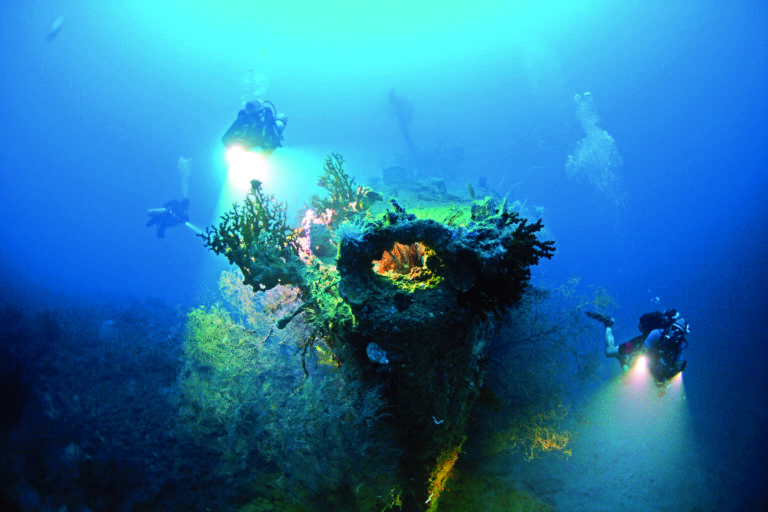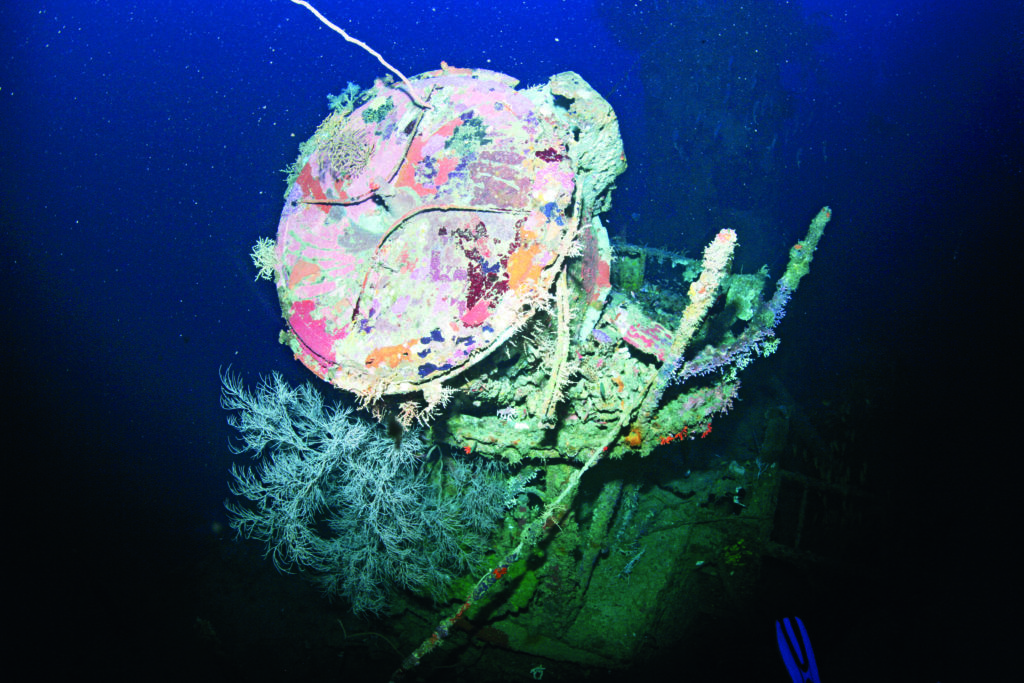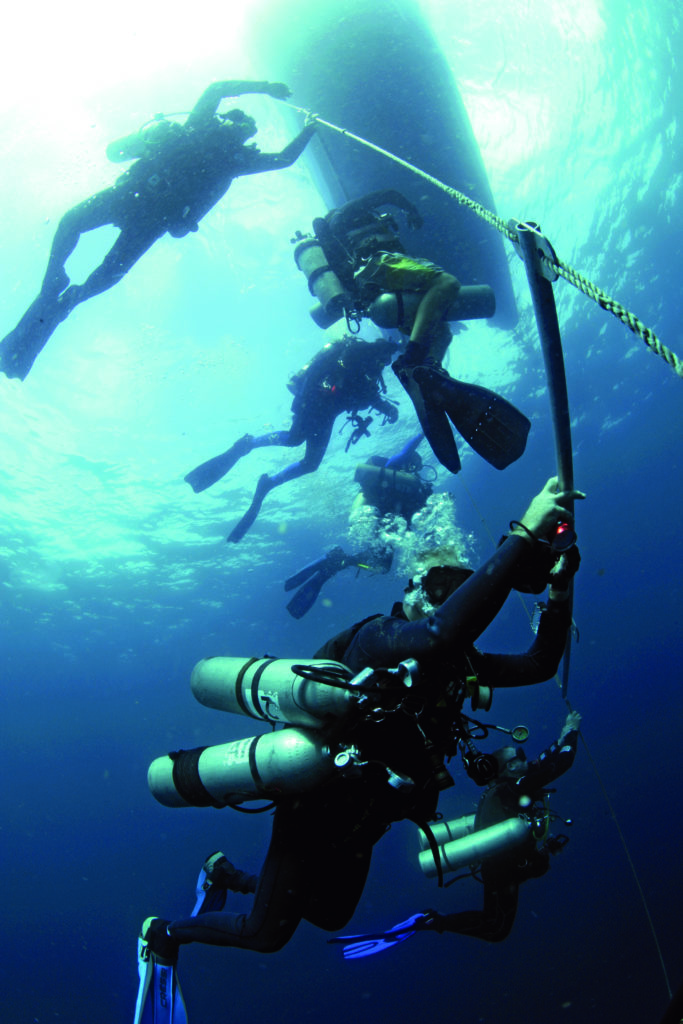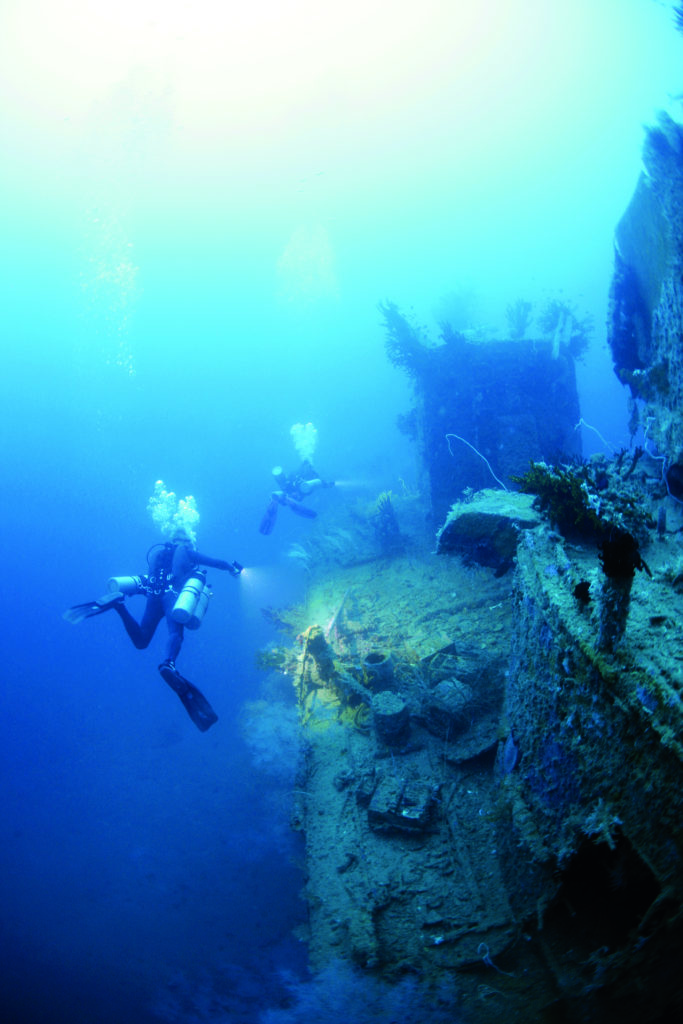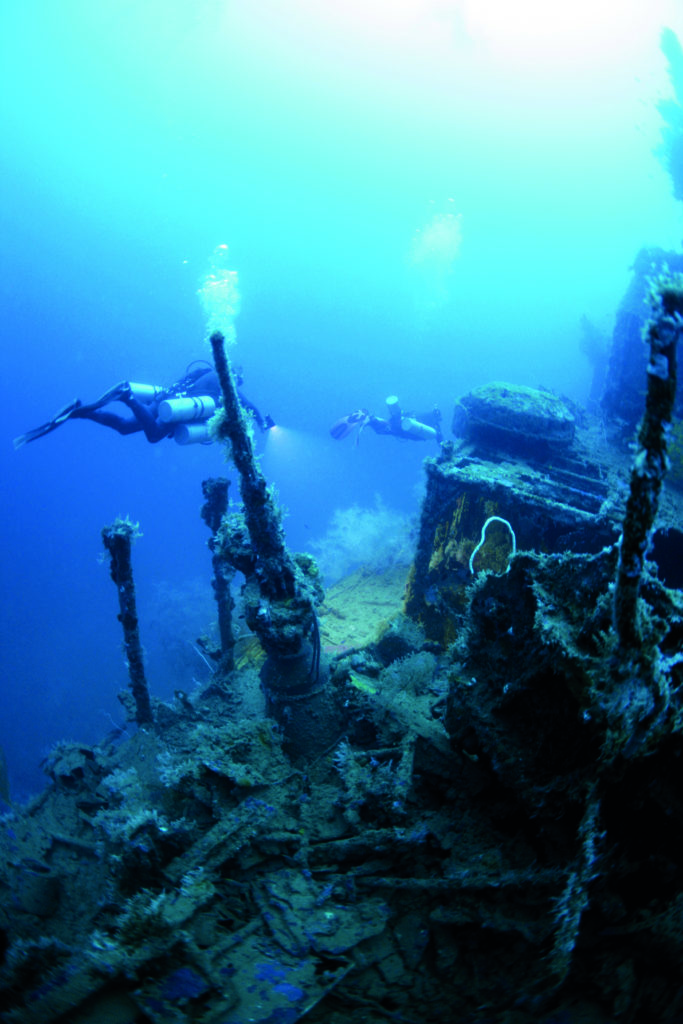The Solomon Islands are steeped in history from World War Two, in particular the epic naval and air battles of Guadalcanal. There are so many ship and aircraft wrecks that the area was given the name Ironbottom Sound, and one of the most famous is that of the USS Aaron Ward. Words and photography by NEIL BENNETT
Also read: Wreck of first kamikaze rocket-bomb victim located
History of the ship
Built by the Federal Shipbuilding & Drydock Company, the USS Aaron Ward was a Gleaves-class destroyer launched on 22 November, 1941. The ship was named in honour of a rear-admiral before heading off to serve in the conflicts at Guadalcanal, one of the Solomon Islands.
The Aaron Ward was an impressive ship: 106m long with a displacement of 2,060 tonnes, and capable of reaching 35 knots.
Her armament was no less formidable, consisting of four 5in DP guns, six half-inch guns, four 40mm AA guns, five 20mm AA guns, five 21in torpedo tubes and six depth-charge projectors with two depth-charge tracks. Today, the 5in guns can be found still pointing defiantly to the skies as the destroyer went down fighting.
‘None of the USS Aaron Ward has been recovered, having managed to escape the attention of salvagers during the 1970s, which is great news for divers’
Having already seen heavy action at Guadalcanal, the Aaron Ward was severely damaged and returned to Pearl Harbor for repairs, but not before her gallant actions were commended as setting an example of fighting spirit in the heat of battle.
After rejoining the fleet, the destroyer again saw action while escorting the LST-499 off Togoma Point. Serving on this ship was junior grade officer Lt John F Kennedy, later to become US president.
During manoeuvres to avoid a dogfight over Savo Island, the Aaron Ward was surprised by three enemy aircraft attacking under cover of the sun. In an attempt to defend herself, she opened fire with her 20mm, 40mm and 5in battery but failed to shoot down the Japanese planes. They were able to release a series of bombs that would eventually prove fatal to the ship.
Three of these bombs managed to strike or near-miss the Aaron Ward, and the first proved devastating, tearing a hole in her side and allowing the forward fire-room to flood.
The second bomb made a direct hit on the engine-room, causing loss of power to the main guns. Shifting to manual control, however, the valiant gunners kept firing until the end.
The third bomb blew a hole in the ship’s port side, causing loss of rudder control. Now helpless, the USS Aaron Ward could only turn in circles, unable to avoid any approaching planes. The bombers attacked again, releasing bombs that all exploded near the destroyer’s port side, killing 20 men, wounding 59 and leaving a further seven missing.
Crippled and helpless, there was nothing the destroyer’s crew could now do to defend the ship.
The Ortolan and Vireo immediately came to Aaron Ward’s aid and tried to beach her on a nearby shoal, but she began to sink stern-first just 550m from safety, and came to rest in 70m of water.
Diving the wreck
In 1995, the USS Aaron Ward was located by marine archaeologist Ewan Stephenson. Today, the wreck lies upright in warm, clear water with its deck at approximately 60m and the bottom at 70m. It is accessible to divers by day-boat from Honiara or by liveaboard.
The wreck is too big to cover in one dive, so decide which area to dive first, taking into account the possibility of currents, especially heading towards the bow.
The mooring line has been set at midships on the wreck’s port side. Those divers intending to penetrate the wreck need to plan very carefully, remembering that the structure has been badly damaged and has collapsed in the centre.
The design of destroyers is such that the corridors are very narrow, which makes them difficult to negotiate with twin-sets and stage cylinders. We have found only a few places where it would be possible to enter the wreck. Remember also that the engine-room took a direct hit, and therefore presents more challenges.
All of the guns point towards the skies, a testament to the last minutes of battle. The bridge has been completely destroyed, leaving a pile of debris in its place with the last remaining searchlight sitting upright on the deck as if it had been there all along. Don’t be misled into thinking that there is little to explore – this is a huge ship and there is still plenty to see.
All of the 5in guns remain intact, as are many of the other guns. It is incredible to think that these huge objects actually stayed attached during the sinking. In front of the bridge are the torpedo-tubes, still full and carrying live explosives. One of the torpedoes has slid partially out of its tube. It’s important to realise that these torpedoes self-arm when released from their tubes. Never tap one!
No part of the USS Aaron Ward has been recovered, having managed to escape the attention of salvagers during the 1970s, which is good news for divers. The deck is covered with shells of every description; the telegraph system used to contact the engine-room can also be found lying on the deck.
The bow is spectacular. Fully intact, it begs to be photographed. Gorgonian corals now grow from the sides. Plenty of ambient light reaches the deck, and lights up the bow like a Christmas parade.
The clarity and warmth of the water can be misleading, giving you a false sense of security. Dropping to the bottom of the bow to get a panoramic shot can take you as deep as 70m, with time rapidly disappearing as you get excited about what you can see through the lens.
Moving towards the stern, the funnel remains undamaged, while the conning tower has now dropped off to the seabed on the starboard side. Again, the guns are still there and the stern is in good condition, although the hull is now distorted from the impact with the seabed.
The stern itself makes for a good photo opportunity, with both the props still in-place down at 70m.
Gases such as helium in the Solomon Islands are very expensive. Although not the ideal method, our choice was to run this as an extended-range dive on air, decompressing on nitrox.
With a bottom time of 25-30 minutes, we were managing to run a deco time of approximately 45 minutes, but it depends where on the wreck you decide to spend your dive time. Tulagi Dive provides a trapeze with its operation, which is essential for this kind of dive. Without it, if the current is running strongly you might find yourself halfway to PNG before you surface!
‘The Solomon Islands provide a beautiful contrast of island time and liveaboard diving that any diver would appreciate’
This is not a dive to be recommended without the right training or gear, and certainly any penetration should be for experienced divers, simply because of the depth and complexity of the wreck, but they will be richly repaid because it is spectacular.
Getting to the wreck
The Aaron Ward doesn’t have to be dived from a liveaboard; the wreck can be treated as a shore destination trip run from Honiara.
Honiara provides a base to explore the wrecks along its coastline while being hosted by Tulagi Dive. When we were there we could simply move across the channel to Tulagi Island and dive the wrecks in this area, though the Raiders Hotel we used as a base there has now closed. From the island, because of the topography of the area, nearly all the sites were located within a 15-minute boat-ride of the hotel.
In Honiara, some of the mainland sites take a little longer to reach but that doesn’t present an issue. The service and quality of the operation there is exceptional, given the challenges remote destinations can present.
The Solomon Islands provide a beautiful contrast of island time and liveaboard diving that any diver would appreciate. Brisbane provides the hub for flights, and useful contacts for wreck-diving in the Solomon islands include New Zealand Diving and Go Dive Pacific.
Also on Divernet: Nation Of Riches More Valuable Than Gold and Nation Of Riches More Valuable Than Gold Pt 2 by Mark B Hatter, Hooked On the Islands by Ellen Husain, Historic Japanese Battleship Wreck Identified
